How many ounces of 2-cycle oil per gallon? This question arises frequently for anyone operating gasoline-powered engines. Understanding the proper mixing ratio is crucial to ensure optimal engine performance and longevity. Join us as we delve into the world of 2-cycle oil, exploring its purpose, types, and the critical aspect of mixing ratios.
By the end of this guide, you’ll have a firm grasp on how to mix 2-cycle oil like a pro, ensuring your engines run smoothly and efficiently.
In this comprehensive guide, we’ll provide clear instructions on accurately measuring 2-cycle oil using various methods. We’ll also present a detailed table outlining the recommended mixing ratios for different engine types and applications. Safety considerations and environmental concerns will be thoroughly addressed, empowering you with the knowledge to handle and dispose of 2-cycle oil responsibly.
Overview of 2-Cycle Oil Usage
2-cycle oil is a specialized lubricant designed for use in gasoline-powered engines that operate on a 2-stroke cycle. Its primary purpose is to provide lubrication and protection to the engine’s internal components, such as the piston, cylinder, and bearings, which are subjected to high temperatures and friction during combustion.
2-cycle oils are typically mixed with gasoline in a specific ratio before being introduced into the engine. This mixture ensures that the oil is evenly distributed throughout the fuel and reaches all critical areas requiring lubrication. Unlike 4-stroke engines, which have a separate oil reservoir, 2-stroke engines rely on the oil-gasoline mixture for lubrication.
Types of 2-Cycle Oils
There are two main types of 2-cycle oils available:
- Mineral-based oils:These oils are derived from refined petroleum and are the most common and affordable type of 2-cycle oil. They offer good lubrication and protection but may not be suitable for high-performance engines or extreme operating conditions.
- Synthetic-based oils:These oils are made from synthetic hydrocarbons and offer superior performance compared to mineral-based oils. They provide better lubrication, reduce friction, and withstand higher temperatures, making them ideal for high-performance engines and demanding applications.
When selecting a 2-cycle oil, it is crucial to refer to the manufacturer’s recommendations for the specific engine. Using the wrong type or ratio of oil can lead to engine damage or poor performance.
Measuring 2-Cycle Oil: How Many Ounces Of 2-cycle Oil Per Gallon

Accurately measuring 2-cycle oil is crucial for maintaining the proper oil-to-gasoline ratio in your engine. Here are some common methods for measuring 2-cycle oil:
Measuring Cups, How many ounces of 2-cycle oil per gallon
Measuring cups are a simple and convenient way to measure 2-cycle oil. They are available in various sizes, so choose one that is appropriate for the amount of oil you need to measure. To use a measuring cup, simply fill it to the desired level and pour the oil into your gas can or fuel tank.
Syringes
Syringes are another accurate way to measure 2-cycle oil. They are particularly useful for measuring small amounts of oil. To use a syringe, draw the plunger back to the desired volume and insert the needle into the oil container. Slowly release the plunger to fill the syringe with oil.
Then, dispense the oil into your gas can or fuel tank.
Graduated Cylinders
Graduated cylinders are the most accurate way to measure 2-cycle oil. They are typically used in laboratories and workshops. To use a graduated cylinder, simply fill it to the desired volume and pour the oil into your gas can or fuel tank.
| Method | Accuracy |
|---|---|
| Measuring Cups | Moderate |
| Syringes | High |
| Graduated Cylinders | Very High |
Mixing Ratios for 2-Cycle Oil
Using the correct mixing ratio for 2-cycle oil is crucial for the proper operation and longevity of your engine. Too much oil can cause fouling of spark plugs, excessive smoke, and decreased engine performance. Too little oil, on the other hand, can lead to engine damage due to insufficient lubrication.
The recommended mixing ratio for 2-cycle oil varies depending on the type of engine and application. Here is a table showing the recommended mixing ratios for different types of engines:
| Engine Type | Mixing Ratio |
|---|---|
| Air-cooled 2-stroke engines (chainsaws, trimmers, etc.) | 25:1 to 50:1 |
| Water-cooled 2-stroke engines (outboard motors, jet skis, etc.) | 50:1 to 100:1 |
| Direct-injection 2-stroke engines (some motorcycles and snowmobiles) | As specified by the manufacturer (typically 50:1 to 100:1) |
Safety Considerations

2-cycle oil, also known as two-stroke oil, is a vital component for the proper functioning of 2-cycle engines found in various equipment such as chainsaws, weed trimmers, and motorcycles. However, it’s crucial to be aware of the potential hazards associated with handling and using 2-cycle oil to ensure safety and minimize environmental impact.
When selecting the perfect bicycle for a woman, consider her height, weight, and riding style. How to choose a bicycle for a woman provides helpful tips to ensure a comfortable and enjoyable ride.
Inhalation of 2-cycle oil fumes or prolonged skin contact can cause irritation and respiratory problems. It’s also flammable and can be harmful if ingested.
If you’re considering purchasing a new bicycle for a woman, there are a few things you’ll need to consider. How to choose a bicycle for a woman will help you make an informed decision. The cost of replacing a speed sensor can vary depending on the make and model of your vehicle.
For more information, check out how much does it cost to replace speed sensor.
Storage
- Store 2-cycle oil in its original container or an approved storage vessel in a well-ventilated area.
- Keep it away from heat sources, open flames, and direct sunlight.
- Ensure the storage area is inaccessible to children and pets.
Usage
- Always follow the manufacturer’s instructions for mixing ratios and proper use.
- Avoid direct skin contact by wearing gloves and protective clothing.
- Use in a well-ventilated area or outdoors to minimize exposure to fumes.
Disposal
- Never dispose of 2-cycle oil in drains, sewers, or waterways.
- Dispose of used oil and oily rags at a designated recycling center or hazardous waste facility.
- Improper disposal can contaminate water sources and harm aquatic life.
By adhering to these safety considerations, you can protect yourself and the environment from the potential hazards associated with 2-cycle oil.
Conclusion
Mastering the art of mixing 2-cycle oil is essential for maintaining the health and performance of your gasoline-powered engines. By following the guidelines Artikeld in this guide, you can ensure that your engines operate at their peak efficiency while minimizing wear and tear.
Remember, the correct mixing ratio is key, and using too much or too little oil can lead to detrimental consequences. So, embrace the knowledge you’ve gained, and let your engines roar with confidence!
Popular Questions
What is the purpose of 2-cycle oil?
2-cycle oil is a specialized lubricant designed for gasoline-powered engines that operate without a separate oil reservoir. It provides lubrication for the engine’s moving parts and helps prevent premature wear and damage.
How do I measure 2-cycle oil accurately?
There are several methods for measuring 2-cycle oil, including using measuring cups, syringes, or dedicated oil measuring tools. Ensure you use a clean and calibrated measuring device for precise results.
What are the consequences of using too much or too little 2-cycle oil?
Using too much oil can lead to spark plug fouling, increased smoke emissions, and engine damage. Conversely, too little oil can result in insufficient lubrication, accelerated wear, and potential engine seizure.
